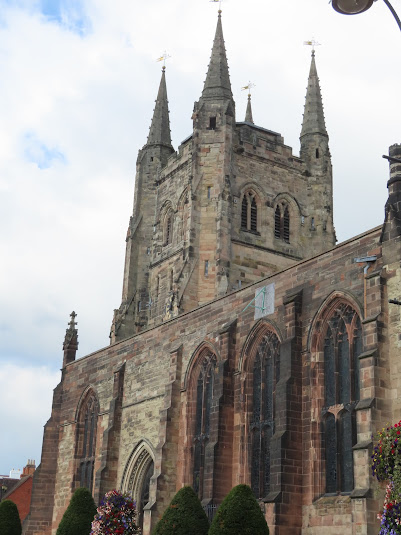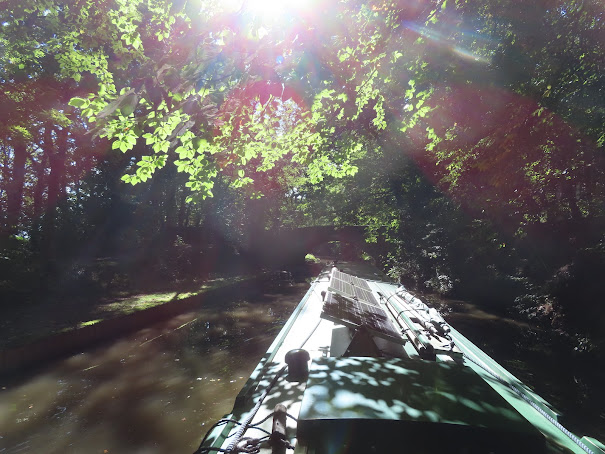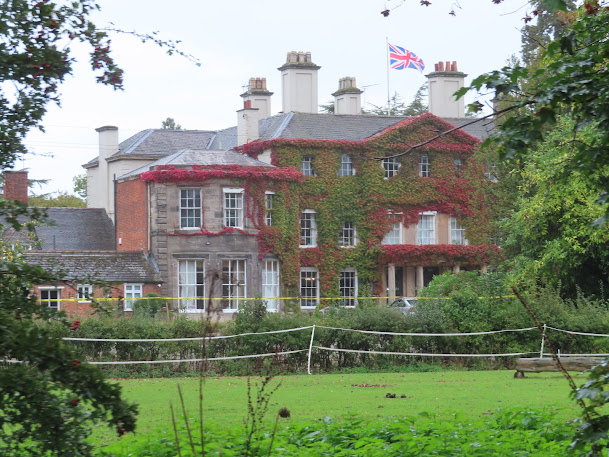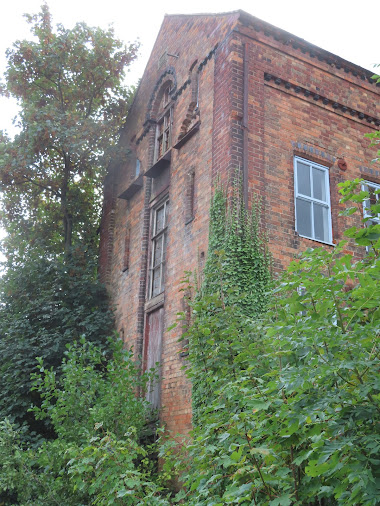We decided that as the rain was supposed to land in Alvecote about lunchtime we would just stay put and go for a walk in the morning and move tomorrow.
We took the path through Pooley Hall Country park known as the Miners Way. It looked to me as if it was a plate or tramway or maybe a railway track of old but looking on the old maps it seems that it has always just been a footpath to get the miners from Amington and Alvecote to the mine at Pooley Hall. Then path takes you past a few ponds that have been caused by subsidence following the extraction of the coal. It seems that the first seems to be worked were only 2 mts below the surface.
We crossed the canal and headed for the Heritage Centre. The head gear pulley is visible from the canal. I wonder if it was from Pooley Hall Colliery, or just a generic one. I also wonder whether it was made by Thompson and Southwick whose engineering business started out near the basin as Glascote and expanded into the brick and tile yard next door.
This sign was never a truer word as we had being daring to believe that the Heritage cafe was open but instead of tease we had a tease!
There were couple of lumps of rock outside the centre that had been carved. One had a couple of animals and a blanket and this one seemed to be a cloth draped over a table with mice running over it. I could find no information about them though.
The Pooley Hall War memorial was erected in 1921 and records 32 men who gave their lives in WWI who had worked at the mine. It is another object often seen from the canal but never visited.
We had also glimpsed the Golden Tower of Leaves from the canal and the Miners Walk goes right past it. It seemed very steep and looked quite slippy with the rain so we gave it a miss. That was our excuse anyway, and I took the photo from the war memorial.
This was Pooley Hall Colliery at its largest extent in 1939. It had started with a pit being dug in 1847 and was producing coal by 1850. By 1897 it had become a limited company and included a brickworks. Many mines in the area had brick and tile works as the coal seams included clay among them. In 1924 the Duke of York (George VI) visited and trusted miners were ordered to form a guard of honour in their Sunday best and a flat cap. If they didn't have a cap they had to buy one, at their own cost! They painted the mine at the bottom of the shaft with white wash and installed a bucket toilet! Also in 1917 it was the first mine to generate its own electricity from excess steam for the winding gear. It was also the first pit to have pit head baths that were installed in 1928. Tamworth Mine became Alvecote Mine in the 1940's and became the access pit for Pooley Hall with man riding and coal hoisting. In 1951 these two pits were merged with Amington Pit to become the North Warwickshire Mine. It all closed in 1965.
Pooley Hall had a wharf for loading canal boats with the coal being brought from the pit head by a single track mineral way. Original this was the entrance to a basin, but by 1921 the basin had been pushed through to the other side of the bend in the canal and this formed an island, as it is today. It appears that there never was a bridge to access the island either.
We walked past Pooley Hall but there are no views of it due to trees. It looks lovely in the few photos and parts for the building date from 1509 but it has seen a lot of changes. We walked back up the canal and enjoyed the peace and quiet and the colours turning. I was hit on the head more than once by acorns dropping from the trees as the wind rose.
When we got back to Alvecote we popped over the bridge to Alvecote Priory ruins. The Priory was set up in 1159 allegedly as a certain William Burdett, on return from the Crusades accused his wife of being unfaithful with his steward and ended up murdering her. When he learned the steward had taken advantage of her he tried to atone by paying for the priory. It was a sub priory of Benedictine Great Malvern Priory. It seemed to only have had around four monks on site for much of the time and was dissolved in 1543. At some stage a house was built on the site using the stone of the priory.
Apparently this was the main entrance to the original priory.
The ruins of today seem to be the rectangular shape with the 'blob' on the upper left corner. Right by the canal is the rectangular dovecote, that is the oldest in Warwickshire. The 1938 shows that the Priory House built after the closure of the priory in 1540 was quite a massive one. It was demolished in the 1960's.
PS. I have just discovered that Alvecote Priory became the Tamworth Agricultural College and Training Farm in 1886. It had closed by 1914.
We had remembered that there had been a horse chestnut tree so we went to find some to keep in the boat to keep the spiders away in winter. (Yes we believe that it works, so long as you use fresh conkers each year!). The map above also shows that there were orchards laid out in the grounds which would explain the presence of the old pear tree by the ruins. So, as well as two pockets of conkers we came home with enough pears for a crumble in the next day or two.



















































